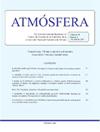Performance evaluation of the WRF model under different physical schemes for air quality purposes in Buenos Aires, Argentina
IF 1
4区 地球科学
Q4 METEOROLOGY & ATMOSPHERIC SCIENCES
引用次数: 0
Abstract
This work presents the performance evaluation of the Weather Research and Forecasting (WRF) model to estimate surface wind speed and direction, air temperature, and water vapor mixing ratio considering 22 configurations at high spatial resolution (1 km) during one week in winter and one week in spring, in order to determine the best-performing schemes for air quality purposes in the Metropolitan Area of Buenos Aires, Argentina. Results show that the use of urban schemes mostly affects wind speed and temperature. The single-layer urban canopy model (UCM) coupled with the Boulac planetary boundary layer (PBL) scheme exhibits the best results for wind speed. Wind direction and water vapor mixing ratio are more sensitive to the land surface model scheme, with results slightly improving with the Noah-MP land surface model. Wind speed and direction errors are larger when the former is lower. When removing from the analysis wind speed values below 2.6 m s–1 for the winter week and 3.1 m s–1 for the spring week, the root mean square errors for wind direction decreased between 50 and 72% of the original value, depending on the configuration and week. Overall, under the studied conditions, configurations including Noah-Mp land surface model or the combination of a simple UCM with BouLac PBL are suitable for air quality applications, as they reproduce both temperature and water vapor mixing ratio relatively well, with errors below 10% and Correlation values above 0.7, and are the best performing configurations for wind direction and speed, respectively.阿根廷布宜诺斯艾利斯不同物理方案下WRF模式的空气质素表现评估
本文介绍了天气研究与预报(WRF)模型的性能评估,该模型在冬季一周和春季一周的高空间分辨率(1公里)下考虑22种配置,以估计地面风速和风向、气温和水蒸气混合比,以确定阿根廷布宜诺斯艾利斯市区空气质量目的的最佳方案。结果表明,城市方案的使用主要影响风速和温度。单层城市冠层模型(UCM)与Boulac行星边界层(PBL)方案的风速模拟效果最好。风向和水汽混合比对陆面模式方案更为敏感,Noah-MP陆面模式的结果略有改善。当前者较低时,风速和风向误差较大。当从分析中去除冬季周低于2.6 m s-1和春季周低于3.1 m s-1的风速值时,风向的均方根误差在原始值的50%到72%之间下降,具体取决于配置和周。总体而言,在研究条件下,Noah-Mp陆地表面模型或简单UCM与BouLac PBL的组合配置适合于空气质量应用,因为它们可以较好地再现温度和水汽混合比,误差小于10%,相关值大于0.7,并且分别是风向和风速的最佳配置。
本文章由计算机程序翻译,如有差异,请以英文原文为准。
求助全文
约1分钟内获得全文
求助全文
来源期刊

Atmosfera
地学-气象与大气科学
CiteScore
2.20
自引率
0.00%
发文量
46
审稿时长
6 months
期刊介绍:
ATMÓSFERA seeks contributions on theoretical, basic, empirical and applied research in all the areas of atmospheric sciences, with emphasis on meteorology, climatology, aeronomy, physics, chemistry, and aerobiology. Interdisciplinary contributions are also accepted; especially those related with oceanography, hydrology, climate variability and change, ecology, forestry, glaciology, agriculture, environmental pollution, and other topics related to economy and society as they are affected by atmospheric hazards.
 求助内容:
求助内容: 应助结果提醒方式:
应助结果提醒方式:


